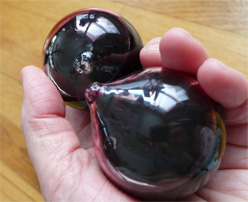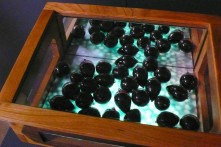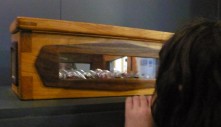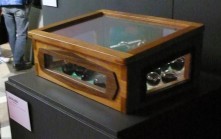Watching Blood Wars Films
I am fascinated by the medium of blood and have become very attached to it as a fluid, as it is a source for many cultural histories and also biological understanding of our heritage.
Included in the website are films of ‘blood battles’ – time lapse microscopy of white blood cells encountering each other. I think these are compelling films. I am still learning how to read these films and the life and death material embedded in them.
WHAT IS HAPPENING IN THE BLOOD WAR CELL FILMS
“The cells fall apart. It is like the human body, it falls apart.
We visualize the cells through their different dyes and these dyes remain in the cell as long as the cells are alive. The surface membrane, which is like the skin, is intact…as soon as they are attacked by a killer cell the membranes are perforated. They get holes and then the dye gets out of the cell. That is actually what we see in these videos, but the cells are still there not functioning properly anymore. The cell is damaged and eventually does not function at all.
—Dr. Luis Filgueira, Australian immunologist
With regards to historical context, this idea of watching film images of cells is a kind of immortalization of the cells, providing the ability to manipulate the moving images in time, shifting them forward and backward, in slow motion and fast forward, freezing frame to observe details. These controls allow us to view life in a way impossible to the naked eye.
Historically microscopy films held a special place for understanding cell functions:
“In 1912, [Alexis] Carrel went to Paris to see Jean Comandon, a medical researcher-turned-fimmaker who was being supported by the Pathé Brothers film production company to make microcinematographic films. In 1913 Comandon, in collaboration with two other biologists who had recently taken up the techniques of [Ross] Harrison and Carrel, produced the first films of cultured cells, Survival of Fragment of the Heart and Spleen of the Chicken Embryo: Cell Division. This film demonstrated the potential of cinematography for observing very slow, very small movements. …
With a camera, an image could be taken with the microscope at regular intervals of seconds or minutes. When the film was then projected at sixteen or twenty-four frames a minute, the very slow movements were greatly accelerated, making previously imperceptible behavior clearly visible. These movements were also greatly magnified by their projection on a movie screen, the films could be shown to large numbers of people at once, and a single movement or a single film could be viewed repeatedly or backwards. This new flexibility of viewing time and the temporal manipulability of the film itself lent to the sense of control over biological time granted to the experimenter by the apparatus of tissue culture.”
—Culturing Life: How Cells Became Technologies, by Hannah Landecker, Pp. 85-86




